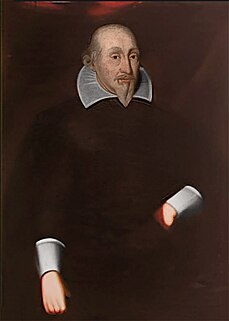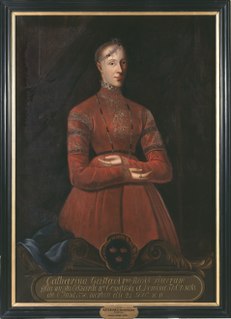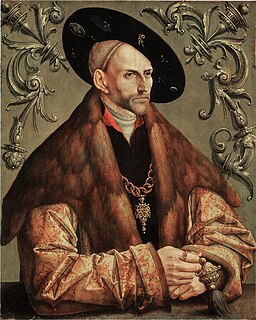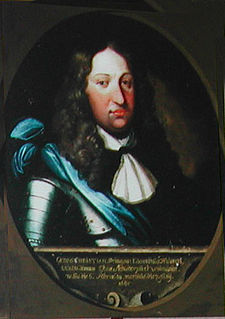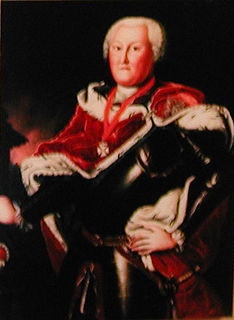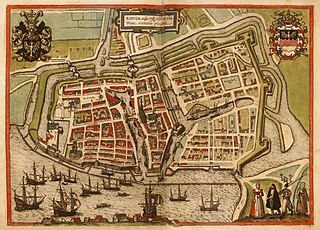| Johan I of East Frisia | |
|---|---|
| Born | 1506 |
| Died | 1572 |
| Noble family | Cirksena |
| Spouse(s) | Dorothea of Austria |
| Father | Edzard the Great |
| Mother | Elisabeth of Rietberg |
Johan I of East Frisia (1506–1572) was a member of the house of Cirksena and a non-reigning Count of East Frisia and later imperial governor of Limburg. His father, Edzard the Great, had introduced primogeniture in the county of East Frisia, so that his older brother Enno II of East Frisia inherited the county alone and he had to hold back. Despite his ambitions, he always acknowledged his brother's rights and did not dispute the inheritance.

The Cirksena are a noble East Frisian family descended from a line of East Frisian chieftains from Greetsiel.

East Frisia or Eastern Friesland is a coastal region in the northwest of the German federal state of Lower Saxony. It is the middle section of Frisia between West Frisia in the Netherlands and North Frisia in Schleswig-Holstein.

The Duchy of Limburg or Limbourg was a state of the Holy Roman Empire. Its main territory including the capital Limbourg is today located within the Belgian province of Liège, with a small part in the neighbouring province of Belgian Limburg, within the east of Voeren.
Unlike his father and his brother, Johan remained a Catholic. After his father's death, he joined the imperial army. However, he soon returned to East Frisia and began supporting his brother. He had, however, little positive impact on his brother, who ruled unwisely. Johan was unable to distinguish himself, and also took some unwise and ill-advised actions, such as those that lead to the Guelders feud. He may also have encouraged Enno to try to re-introduce Catholicism in East Frisia. This attempt was cut short when Enno died in 1540. Enno's widow, Anna became regent for her son Edzard II. Johan had an endless series of conflicts with Anna.
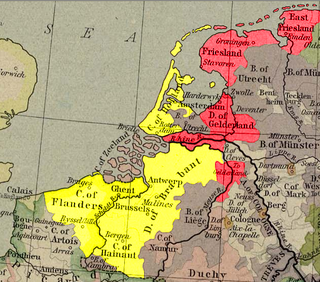
The Guelders Wars were a series of conflicts in the Low Countries between the Duke of Burgundy, who controlled Holland, Flanders, Brabant and Hainaut on the one side, and Charles, Duke of Guelders, who controlled Guelders, Groningen and Frisia on the other side.

Anna of Oldenburg was a Countess consort of East Frisia as the spouse of Count Enno II of East Frisia. She was the Regent of East Frisia in 1540/42–1561 as the guardian for her minor sons. Her reign lasted until 1561 and was generally supported by the Estates. Her chief advisor was her brother, count Christopher of Oldenburg. When she died in 1575, it was exactly 35 years after her own husband's death.
A regent is a person appointed to govern a state because the monarch is a minor, is absent or is incapacitated. The rule of a regent or regents is called a regency. A regent or regency council may be formed ad hoc or in accordance with a constitutional rule. "Regent" is sometimes a formal title. If the regent is holding his position due to his position in the line of succession, the compound term prince regent is often used; if the regent of a minor is his mother, she is often referred to as "queen regent".
In 1538, Johan married Dorothea of Austria, the illegitimate daughter of Emperor Maximilian I. In 1543, Emperor Charles V reminded Johan of the fact that he was still, technically, in the imperial service. Charles appointed Johan as stadtholder of the Duchy of Limburg, Falkenburg and Dalheim. From that time onwards, Johan was colloquially called Count Johan of Falkenburg.

Maximilian I was Holy Roman Emperor from 1508 until his death. He was never crowned by the Pope, as the journey to Rome was always too risky. He was instead proclaimed Emperor elect by Pope Julius II at Trent, thus breaking the long tradition of requiring a papal coronation for the adoption of the imperial title. Maximilian was the son of Frederick III, Holy Roman Emperor, and Eleanor of Portugal. He ruled jointly with his father for the last ten years of the latter's reign, from c. 1483 to his father's death in 1493.
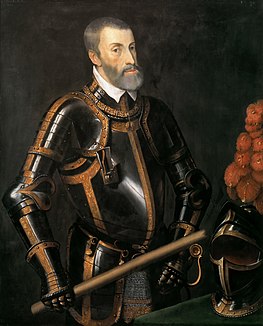
Charles V was Holy Roman Emperor (1519–1556), King of Spain and ruler of the Spanish Empire, Archduke of Austria, and ruler of the Habsburg Netherlands (1506–1555). The Spanish conquest of the Aztecs and Incas, and the German colonisation of Venezuela both occurred during his reign. Charles V revitalized the medieval concept of the universal monarchy of Charlemagne and travelled from city to city, with no single fixed capital: overall he spent 28 years in the Habsburg Netherlands, 18 years in Spain and 9 years in Germany. After four decades of incessant warfare with the Kingdom of France, the Ottoman Empire, and the Protestants, Charles V abandoned his multi-national project with a series of abdications between 1554 and 1556 in favor of his son Philip II of Spain and brother Ferdinand I of Austria. The personal union of his European and American territories, spanning over nearly 4 million square kilometres, was the first collection of realms to be defined as "the empire on which the sun never sets".

In the Low Countries, stadtholder was an office of steward, designated a medieval official and then a national leader. The stadtholder was the replacement of the duke or earl of a province during the Burgundian and Habsburg period (1384–1581/1795).
His descendants lived at Coldeborg Castle in the Rheiderland and were financially supported by the counts of East Frisia.

The Rheiderland is a region of Germany and the Netherlands between the River Ems and the Bay of Dollart. The German part of the Rheiderland lies in East Frisia, west of the Ems. The Dutch part lies in the Dutch province of Groningen and is mostly part of Oldambt. The Rheiderland is one of the four historic regions on the mainland in the district of Leer; the others being the Overledingerland, the Moormerland and the Lengenerland.

